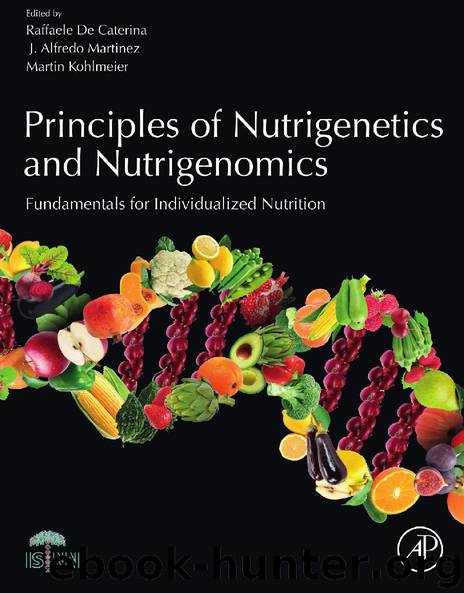Principles of Nutrigenetics and Nutrigenomics by unknow

Author:unknow
Language: eng
Format: epub
Tags: Principles of Nutrigenetics and Nutrigenomics: Fundamentals of Individualized Nutrition, (2020) 588pp. 978-0-12-804572-5
ISBN: 5904579
Publisher: Elsevier Science & Technology
Published: 2019-09-20T23:33:02+00:00
NIACIN AND INFLAMMATION
291
regulating the expression of the key genes involved. In
SIRTs have a key role in regulating endothelial and
keeping with the protective role for promoting the effi-
vascular homeostasis. In the case of SIRT1, it has been
cient use of the limited resource, SIRT1 and SIRT2
demonstrated that increased NO production promotes
have been shown to inhibit adipogenesis. SIRT1 pro-
endothelial-dependent vasodilation by targeting endo-
motes adipogenesis inhibition as well as a switch from
thelial NO synthase and regulates the expression of
white fat adipocytes to metabolically active brown fat
many genes involved in vascular endothelial homeosta-
by inhibiting the transcription activity of the master
sis, angiogenesis signaling, and remodeling through the
regulator of adipogenesis PPARg. This mechanism in-
deacetylation of FOXO1.
volves direct deacetylation of PPARg and binding of
SIRT1 with the PPARg corepressors nuclear receptor
corepressor and silencing mediator of retinoid and thy-
NIACIN AND VASCULAR HOMEOSTASIS
roid hormone receptors. SIRT1 has also been implicated
in NASH, because Sirt1/ mice were found to be more
As a consequence of the hypolipidemic effects of
prone to developing hepatic steatosis than were wild-
niacin, reduced thrombocyte aggregation and blood vis-
type animals. The involvement of SIRT2 has been associ-
cosity have also been observed. Niacin treatment using
ated with the modulation of transcription factor FOXO1
HepG2 cells lowers plasminogen activator inhibitor-1,
activity, altering the expression of regulators PPARg,
a factor possibly involved in atherogenesis and throm-
CCAAT-enhancer-binding protein a, and causing the
bosis, and intercellular adhesion molecule 1 levels, a
repression of markers of terminal adipocyte differentia-
cell surface glycoprotein important for the adhesion of
tion, such as Glut4, aP2, and fatty acid synthase. In
white blood cells to vascular surfaces, and which has
contrast, mitochondrial SIRT3 and SIRT5 promote fatty
significant properties as a predictor of future coronary
acid b-oxidation by regulating pyruvate dehydrogenase.
events (Tavintharan et al., 2007). Interestingly, among
SIRT6 has also been linked to fatty acid synthesis inhibi-
the SIRT family, SIRT1 is the only one reported to control
tion, because fatty acid transport and lipogenesis are
angiogenesis
signaling,
by
modulating
postnatal
induced in Sirt6/ livers in mice. Hepatic SIRT7 has
vascular growth through FOXO1 deacetylation.
been proposed to have a role opposite the other SIRTs
in lipid metabolism, in which SIRT7 promotes the
expression of genes involved in fatty acid uptake and
NIACIN AND ISCHEMIA
synthesis of triglycerides by inhibiting DCAF1/DDB1/
CUL4B E3-dependent polyubiquitination of transcrip-
An interesting link was established between niacin
tion factor TR4. Consistently, Sirt7/ mice accumulate
administration and the attenuation of reperfusion
less body fat and are more resistant to developing
injury; tissue damage occurs when blood flows into
high-fat dieteinduced obesity.
the tissue after a period of ischemia. Niacin treatment
leads to improved kidney ischemia-reperfusion (I/R)-
induced cardiac dysfunction and the severity of
NIACIN IN ENDOTHELIAL
myocardial LPO through sustained myocardial PGC-
DYSFUNCTION
1a expression. I/R injury can also be suppressed by
SIRT1 or SIRT6, whose functions either induce auto-
Endothelial dysfunction is a condition characterized
phagy in liver or are essential to ensure the sodium
by an imbalance between vasodilating and vasocon-
sulfideemediated cytoprotective effect in brain endo-
stricting substances produced by endothelial cells, which
thelial cells, respectively. Whereas SIRT1 and SIRT6 sup-
may result in raised blood pressure, reduced vasodila-
press I/R injury, SIRT2 inhibition and/or depletion in
tion, and proinflammatory and prothrombotic states.
mice promote protection from ischemic injury.
Niacin can improve endothelial function under vascular
injury and endothelial tube formation under lipotoxic
and hypoxic conditions, which are
Download
This site does not store any files on its server. We only index and link to content provided by other sites. Please contact the content providers to delete copyright contents if any and email us, we'll remove relevant links or contents immediately.
Nutrition for Sport, Exercise, and Health by Spano Marie & Kruskall Laura & Thomas D. Travis(3559)
Nutrition for Sport, Exercise, and Health by Marie Spano & Laura Kruskall & D. Travis Thomas(3553)
The Sprouting Book by Ann Wigmore(3414)
Flavor Flours by Alice Medrich(2648)
Memory Rescue by Daniel G. Amen(2260)
Superfood Smoothie Bowls: Delicious, Satisfying, Protein-Packed Blends that Boost Energy and Burn Fat by Chace Daniella(2239)
Dirty Genes by Ben Lynch(2163)
The Bad Food Bible by Aaron Carroll(2125)
The Poisoner's Handbook by Deborah Blum(1983)
Genius Foods by Max Lugavere(1977)
Good Calories, Bad Calories by Gary Taubes(1954)
The Main Street Vegan Academy Cookbook by Victoria Moran(1942)
The I Quit Sugar Cookbook by Sarah Wilson(1880)
Core Performance Essentials by Mark Verstegen(1862)
Memory Rescue: Supercharge Your Brain, Reverse Memory Loss, and Remember What Matters Most by Amen Dr. Daniel G(1850)
Big Girls Do It Stronger by Jasinda Wilder(1805)
Android App Development by Franceschi Hervé J.;(1735)
Sugar Crush by Dr. Richard Jacoby(1689)
Dr. Colbert's Keto Zone Diet by Don Colbert(1549)
